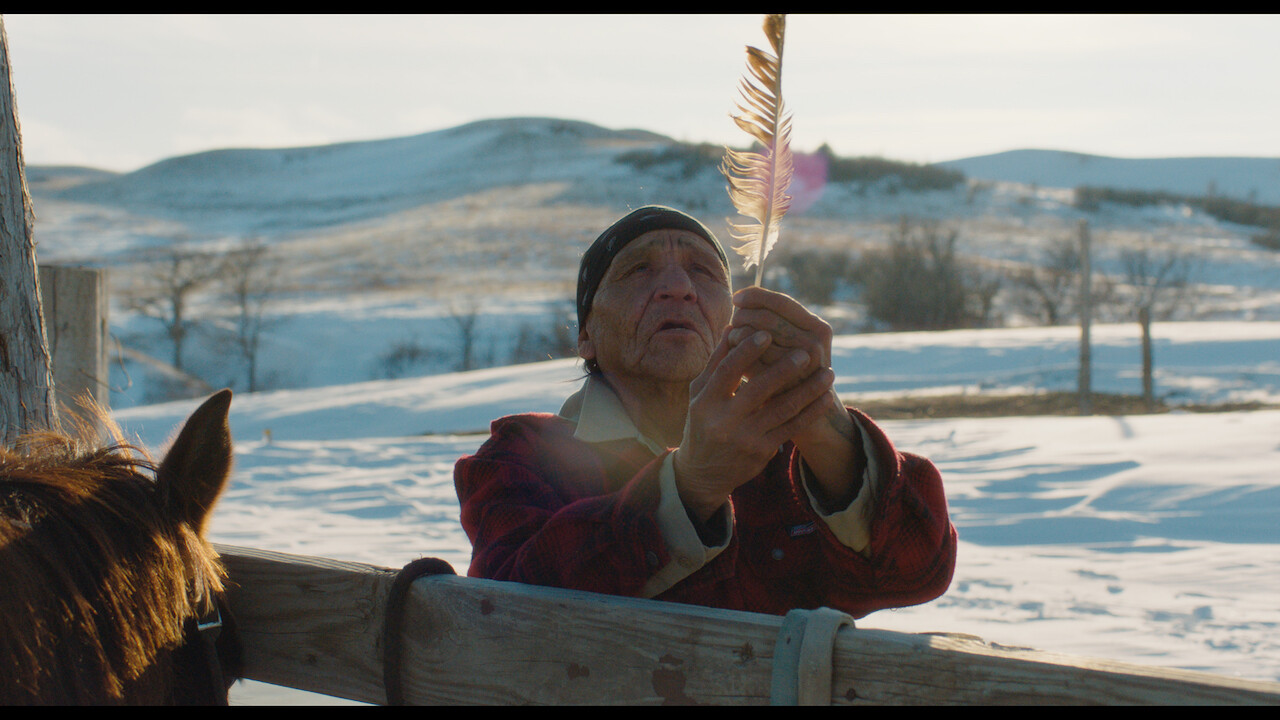

Film still from Lisandro Alonso, Eureka (2023).
It is enough to talk to anyone in their twenties today—as happens to me while teaching film studies at an American public university—to get a sense of how the discourse around film and moving images has evolved in the last generation. Those in their twenties today have already spent most of their formative years, in terms of audiovisual education, in the era of streaming platforms: where screens and moving images are juxtaposed without canon and hierarchy. They are already native streamers, so to speak. The change in the social mediation of images has also necessarily transformed the way in which images are collectively analyzed and understood, and therefore the way in which we write about them.
It would seem meaningless to speak today of a crisis in film criticism, when at the Cannes Film Festival the number of accredited journalists has skyrocketed in the last few years. (Along with the old school of daily newspapers and movie magazines, there are more and more blogs, YouTube reviewers, social media accounts, podcasts, and so on.) As a result, the festival experience has now become a living hell, from overcrowded theaters to the increasing difficulty of finding tickets. However, the transformation of film criticism is not tantamount to its disappearance, but rather a matter of redefining its social function: it is now a “point of view” indistinguishable from that of the common spectator, because it is often interchangeable with it. Film criticism “does not criticize” anymore. This does not mean that it refrains from making evaluative judgments (if anything, it does so more and more in an increasingly subjective and idiosyncratic way). Rather, it can no longer produce a hierarchization of images (although “hierarchization” is perhaps not the best term, given that apologists for this process would respond that what’s taking place is a democratization and subversion of hierarchies). Film critics are no longer able to properly interrogate images that are becoming less and less mediators of the world—which also means questioning and making sense of it—but are rather indistinguishable from it.
A colleague of mine, during a break between screenings, commented that this year’s Cannes program looks like the homepage of a Netflix-type platform: there is a lot of stuff, but it’s all chaotically piled up without order or form. Everything seems to be there, yet you do not feel like watching anything. The festival schedule is now a frightening monster where you can find everything and its opposite: where Premieres, Out of Competition, and Special Screenings sections—which used to be extra “additions” to the curated official sections of Competition and Un Certain Regard—are now so humongous to have become another festival within the festival. This year, just to give an idea, the Special Screenings and Premieres sections feature the new Indiana Jones film, Scorsese’s Killers of the Flower Moon, the highly anticipated world-premiere of Sam Levinson’s HBO TV Show The Idol, plus films by Valérie Donzelli, Lisandro Alonso, Takeshi Kitano, Wim Wenders, Pedro Costa, Steve McQueen, Kleber Mendonça Filho, Wang Bing, Pedro Almodovar, Anurag Kashyap, Robert Rodriguez, etc. The glut of films has become so great that many of them become de facto “invisible,” relegated to marginal theaters at impossible hours. The impression is that it’s more important for those films to be at Cannes than to actually be seen. The analysis of a film is now secondary: it is enough to be in the program (and this also applies to the great symbolic asset for many accredited journalists: being able to see a film before everyone else and post about it on social media).
Cannes—which boasts about being the most renowned alternative to the cinema of the streaming giants, which are now the true new majors in Hollywood—thus ends up reproducing not so much the content of streaming platforms (films that are released directly on Netflix and do not have a theatrical release are still not allowed to participate in the competition), but much more insidiously, its form. Images now exist side by side, with no discourse—critical or curatorial—able to give a form to them. It’s as if the festival itself, from being an institution in charge of the social mediation and canonization of images, has been swallowed by the violent social disintermediation that has characterized neoliberal societies as a whole in recent decades (and which in cinema has been specifically accelerated since the dominance of digital images).
In fact, if we were to ask the above-mentioned twenty-year-olds how their choice of images and films are “determined” or “given form,” they would point to apps like Letterboxd, websites like IMDB and Rotten Tomatoes with their rating systems, or subreddits dedicated to niche topics. The success of Letterboxd in this sense represents an emblematic shift: the discourse about a film is no longer “mediated” by a qualified figure (with formal training) or a partially qualified one (as in the tradition of militant film criticism), but by an enormous amount of data that reflects an “average” opinion (which is established from a user-generated horizontal level, which is also indifference). Just as the homepage of Netflix or Amazon Prime is generated from user data, so Letterboxd represents the ultimate shift from the “mediation of film criticism” to “data mediation.” It’s as if the symbolic order of images is no longer mediated or ordered, but is now nothing more than an “average” of a general/generic discourse. In the name of dethroning the privileges of speech and the democratization of discursive production, discourse about films is now increasingly organized and generated by data.
The fact that even at Cannes—allegedly one of the last filmic institutions where a qualified and not market-driven mediation of film discourse still prevails—the juxtaposition of unrelated content, as in this year’s program, now reigns unchallenged. This is an indication that what we are currently witnessing is a fundamental transformation of the symbolic order through which we mediate and give form to our experience of watching images. Or perhaps it is a sign that we have entered a structural crisis of that very symbolic order.
Among the films screened during the first few days of the festival, one that indirectly addresses this phenomenon is Occupied City by Steve McQueen (director of 12 Years a Slave, Hunger and Shame). Presented out of competition, the film is a four-hour documentary on the Nazi occupation of Amsterdam during World War II. McQueen’s gesture in this film is to juxtapose contemporary images of the city with a voice-over narrating—house by house, building by building—what happened in that very place during the years of occupation. The estrangement effect is produced by the clash between contemporary images of daily life in the city, and what the words say about what happened there eighty years ago, of which there is usually no trace left. While the insistence on the present and the absolute absence of archival footage might suggest an almost Lanzmannian approach to history, the film ultimately seems to take a different tack. The vignettes that McQueen creates—each one lasting only a few minutes and usually going no deeper than an anecdote—are repeated in the same form over and over again for four hours, giving the viewer the impression of a reality made up of many small, juxtaposed details, lacking symbolic ordering, cohesiveness, and sense. It is as if history, composed of many small pieces placed side by side, no longer gives a clear image of itself, despite the massive amount of information that we receive during the film (the voice-over is nonstop for the entire duration). McQueen has accustomed us to historical narratives made up of immediate, bodily, almost prelinguistic sensations; emblematic is the narrative of slavery in 12 Years a Slave, centered on sensations of bodily pain rather than the political and historical dimensions of the phenomenon. Here, in a similar fashion, we have a radically opaque image of history, devoid of any form or meaning. The greater the number of words, the more our understanding of history diminishes.
Another film whose form implicitly addresses a crisis of the symbolic ordering and sense-making of images is Lisandro Alonso’s Eureka. Almost ten years after Jauja, Alonso goes back to tell a Native American fable intertwining different story lines, without ever explaining or showing the connection between them. Jumping from a seemingly classic black-and-white Western film on the occupation of the frontier (with protagonists Viggo Mortensen and Chiara Mastroianni), to the story of a police woman in present day South Dakota, to finally a story set among an Indigenous group in 1970s Oaxaca, the Argentinian director experiments with the connectivity between images without showing the causal ordering principle that would guarantee a cohesive narrative structure. The key is a sentence pronounced by a shaman roughly in the middle of the film, when he claims that time has always been a human fiction and what really connects different forms of experience is space. And in fact the three story lines, belonging to different temporalities (the third one chronologically precedes the second), are deprived of a proper causal connection between them. Alonso is not new to experimenting with nonlinear storylines, but here it seems that what he’s searching for is a theoretical way to tell stories without referring to a principle of hierarchization or a causal link. His cinematographic style might actually indicate a different path (predicated on Indigenous epistemology and aesthetics) that seeks to give form to images without rely on the modernist symbolic order of hierarchical organization and sense, instead relying on looser horizontal connections. But the question remains: Is this enough to find a way out of the crisis of the visual symbolic order? Could this be a way to conceptualize a new and different symbolic order between images?
